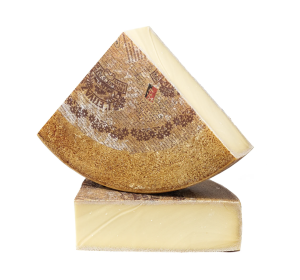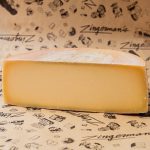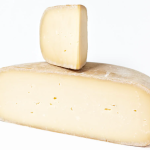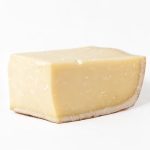Excerpt from Ari’s Top 5 enews
An exceptional taste of 19th century Switzerland
 One of the beauties of great artisan cheese is that no two batches are ever exactly the same. Like a great musician performing the same special song night after night, the best cheeses are always really good. Sometimes though, there’s a particular batch that just goes a bit farther. What’s always an exceptional 9 out of 10, will now and again, unexpectedly take it all the way to the top. Those are times when the flavors are so fine that they stop me in my tracks and make me take notice in a whole new way, which is exactly what happened when I tasted this exceptional batch of L’Etivaz cheese from Switzerland.
One of the beauties of great artisan cheese is that no two batches are ever exactly the same. Like a great musician performing the same special song night after night, the best cheeses are always really good. Sometimes though, there’s a particular batch that just goes a bit farther. What’s always an exceptional 9 out of 10, will now and again, unexpectedly take it all the way to the top. Those are times when the flavors are so fine that they stop me in my tracks and make me take notice in a whole new way, which is exactly what happened when I tasted this exceptional batch of L’Etivaz cheese from Switzerland.
It will be 30 years ago this summer that I stumbled onto L’Etivaz cheese when I was traveling with a small band of cheese aficionados—my friend and cofounder of Neal’s Yard Dairy, Randolph Hodgson; his then-business-partner Jane Scotter; Anita LeRoy (founder of Monmouth Coffee in London) and my late, much-missed friend Daphne Zepos (who I’m confident would have loved learning from Dilar Dirik’s work). We had gone to Switzerland to visit cheesemakers. L’Etivaz was not on our list—in fact, we’d never even heard of it. Like the quality of this current batch, when we stumbled on it, it happily caught my attention. And in the best possible way, both the memory and the cheese are still very much with me.
The chance meeting happened on the third or fourth day of the trip, having already been to half-a-dozen dairies, with visits scheduled for another three or four still to come. We were driving quietly down the road in our van when we saw a bunch of evenly cut wooden boards leaned up to dry in the mountain sun. We’d learned that boards drying meant that a dairy was nearby—dairies washed the wood shelves from their maturing rooms, and then set them out to dry on sunny days. These particular boards turned out to belong to a dairy that made a cheese that was called L’Etivaz.
Today, L’Etivaz has a Wikipedia page, but 30 years ago it was pretty much unknown outside its home region. By 1994, I’d already read dozens of cheese books, but had never seen a word written about it. L’Etivaz was formally brought into existence in 1932. While most of the cheese world back then was moving more and more into industrialization, 76 families who farmed the land around the town of L’Etivaz decided to go in the other direction. Following the frame above,
-
They knew and cared deeply about their history and tradition.
-
They were clear about their values and philosophy.
-
They found a way to make the cheese in a way that kept it very alive and wonderfully well.
The piece I tasted last week is evidence of the effectiveness with which they made this life recipe work.
In the context of my new mantra, they had a very different theory about cheesemaking than the rest of the marketplace. Going back to the early 1930s, these 76 families had become increasingly concerned that the quality of traditional mountain Gruyère cheese they’d grown up with was getting worse with each passing year. With that in mind, they decided to withdraw from what they felt was ever more mass market focused, government-managed Gruyère program to create their “own” cheese. To stay true to their values, they turned away from significant government subsidies afforded to officially-approved cheesemakers in Switzerland in order to stay true to tradition.
To this day, the production of L’Etivaz remains highly restricted. In an example of what meaningfully effective practice means, 72 of the original 76 farms are still making cheese today. Together, they produce just 19,000 wheels of cheese a year. L’Etivaz can be made only in spring, summer, and early autumn when the cows are up at high altitudes in the Alpage, between 3,500 and 6,500 feet above sea level.The cheese can be made only by those farms, and each farm can use only the milk of its own herd—no milk is ever purchased to make it.
The altitude ensures that the cows are grazing on an amazing array of wild herbs, tiny mountain flowers, and assorted green grasses. No chemicals are allowed to be added at any point in the process, from field to finished cheese, so L’Etivaz is essentially organic. It must be made using raw milk, which must be warmed in traditional copper kettles. And, true to tradition, the heat for the kettles must come from open wood fires!
This newly arrived batch of L’Etivaz is, as I said, particularly special. At just over a year and a half old, it has a wonderfully balanced, beautifully full flavor. Smooth and creamy, a hint of brown butter, a lovely bit of salt, and a super clean, long finish. Surprisingly subtly sweet in the most balanced way. Not at all salty or bitter, with a smattering of those crunchy bits of crystallized amino acids that well-aged cheeses like this one will get. A tiny sliver evoked a big “Wow!” from Tammie who tried it at our house the other evening.
You can eat the L’Etivaz on its own. It’s great on the Bakehouse’s Vollkornbrot, Dinkelbrot, or Country Miche spread with the Vermont Creamery Cultured Butter and a good bit of freshly ground black pepper. It’s just right for grilled cheese, fondue, or after dinner with fresh fruit and walnuts. It’s what my friend Randolph Hodgson would have referred to as a “thirty miler.” What’s that mean? “You know,” he answered matter-of-factly. “Thirty miles down the road it still tastes great!”



